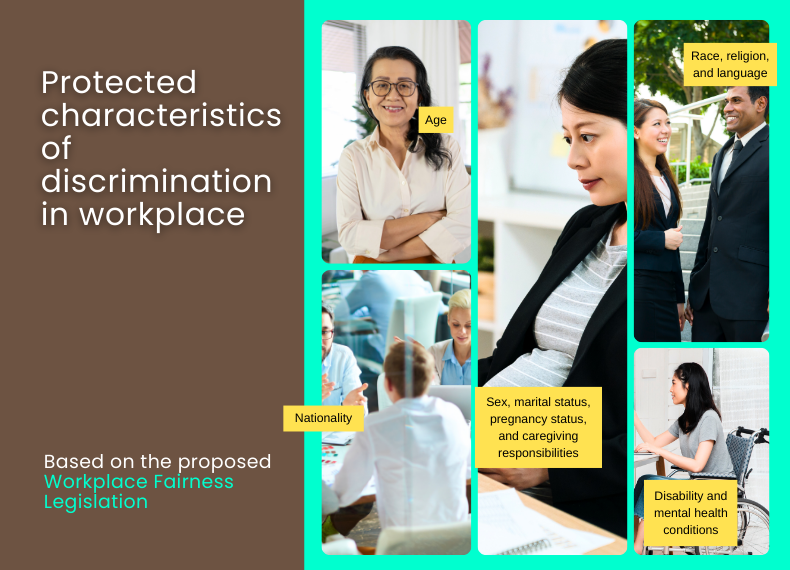
Singapore does not have an overarching anti-discrimination law yet. Still, it actively promotes fair employment practices. It provides guidelines and resources to prevent discrimination in the workplace overseen by the Ministry of Manpower (MOM) and the Tripartite Alliance for Fair and Progressive Employment Practices (TAFEP).
A new legal legislative framework, Workplace Fairness Legislation (WFL) has been proposed by the Tripartite Committee and it has recommended the following protected characteristics to prohibit workplace discrimination:
Age:
This involves bias against employees due to their age. Employers should hire based on merit rather than age and to re-employ older workers.
Nationality:
Employers should not discriminate based on nationality and should promote a diverse and inclusive workforce.
Sex, marital status, pregnancy status, and caregiving responsibilities:
Employers should treat male and female employees equally in hiring, promotion, and benefits, and thereby, organizations should restrict unfair treatment based on gender, including pregnancy and discrimination based on an employee's marital status or family responsibilities. Employers are encouraged to provide flexible work arrangements to support employees with family commitments.
Race, religion, and language:
Employers should not discriminate based on race or ethnicity and promote racial harmony and inclusiveness. They must also respect employees' religious practices and make reasonable accommodations where possible, such as allowing time off for religious observances.
Disability and mental health conditions:
Discrimination against individuals with physical or mental disabilities to be addressed through initiatives encouraging inclusive hiring practices and workplace accommodations.
Organizations can adopt several strategies to track measurable progress in addressing workplace discrimination. These may include establishing clear benchmarks and goals for diversity and inclusion, conducting regular audits of employment practices, and collecting and analyzing data on recruitment, promotion rates, and grievance outcomes across different demographic groups.
Implementing and tracking participation in training programs on unconscious bias and diversity can also provide insights into an organization's progress toward creating a more inclusive workplace.
Regular reporting on these metrics can help organizations evaluate the effectiveness of their initiatives and make informed adjustments to their strategies. Engaging with external audits or certifications related to workplace equality can also offer an independent assessment of an organization's progress and benchmarking against industry standards or best practices.
Here is a range of metrics and benchmarks for SMEs to consider and track that not only help in assessing the current state of diversity and inclusion within an organization but also in identifying areas for improvement and tracking progress over time.
Before the law is enacted, all businesses should develop fairness policies and promote a culture of respect and dignity amongst their employees.
While organizational policies and awareness initiatives are the foundation of the preventive strategies, KarmaV AI analyses data from multiple sources to detect discrimination risks and provide ample lead time for the organization to review and implement corrective measures.
0 Comments
No Comments Found.